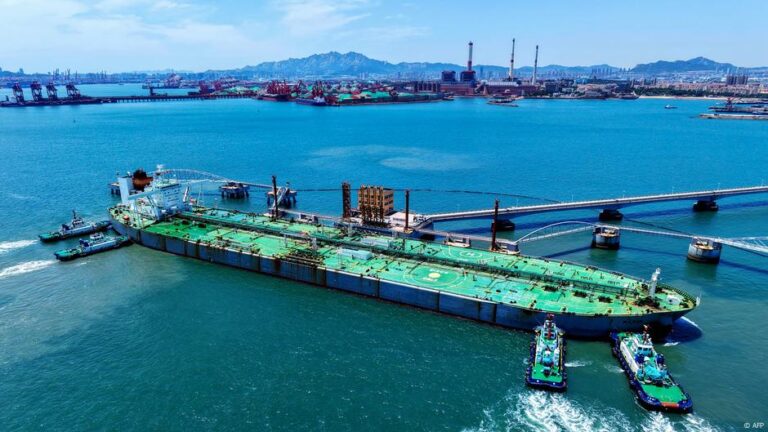India and China have pushed back firmly against US President Donald Trump’s threats of secondary sanctions — penalties for doing business with a sanctioned country — over their continued purchases of Russia’s oil, which is a key revenue stream for Moscow’s war in Ukraine.
Both nations vowed to protect their energy security and economic sovereignty against what Beijing firmly called “coercion and pressure” from the United States. China became the biggest importer of Russian oil in 2022.
India, meanwhile, accused the West of hypocrisy, pointing out that the European Union continues to import Russian energy, despite having massively reduced its reliance on it since the war began..
New Delhi further noted that Washington had actively supported its oil purchases from Russia, which ramped up shortly after the Russian invasion, to help stabilize global oil prices.
India’s oil purchases from Russia grew nearly 19-fold from 2021 to 2024, from 0.1 to 1.9 million barrels a day, while China’s rose by 50% to 2.4 million barrels a day.
Petras Katinas, a Lithuania-based energy analyst at the Centre for Research on Energy and Clean Air (CREA), told DW that India, Russia’s second-largest oil buyer, had saved up to $33 billion in energy costs between 2022 and 2024 as Moscow offered large price cuts when the US and Europe cut their reliance on Russian oil and gas.
India’s longtime policy of balancing ties with the US, Russia and China, without prioritizing any side, had “underpinned” the decision to buy discounted Russian crude, with New Delhi “prioritizing energy security and affordability,” Katinas said.
Trump’s new sanctions threat roils markets
Having already imposed a25% tariff on Indian imports, Trump issued an executive order on Wednesday, imposing an additional 25% tariff on India-made goods over its purchases of Russian oil.
Oil prices rose nearly 1% on the news, while Indian media outlets reported that the new levy could spike the country’s oil bill by up to $11 billion. New Delhi labeled the additional levy “unfair, unjustified and unreasonable.”
Trump said the tariffs would take effect in 21 days, giving India and Russia time to negotiate with the administration on the import taxes. The president was also expected to announce wider secondary sanctions on other countries and entities with which Russia trades oil.
Secondary sanctions would be another major blow for the Russian economy, already reeling from Western sanctions. With military spending now exceeding 6% of GDP and real inflation estimated by some analysts at 15-20% versus the official 9% figure, Russia is burning through cash, putting serious pressure on its budget and arms factories.
For global markets, new sanctions could trigger a seismic shock in energy prices and trade flows reminiscent of 2022, when the oil price surged and Russia bypassed Western sanctions by striking discounted energy deals with two of the world’s largest economies.
“If India had not bought Russian crude [in 2022], it’s anyone’s guess what the oil price would have been — $100 (€86), $120, $300 [per barrel],” Sumit Ritolia, a New Delhi-based oil analyst from trade research house Kpler, told DW. WTI crude hovered between $85 and $92 per barrel in the weeks before the invasion.
Trump’s 25% “secondary tariff” could now leave India with no choice but to scale back at least some of its oil trade with Russia. Any additional sanctions would only make matters worse.
Katinas said secondary sanctions “raise the stakes” significantly, “threatening Indian companies’ access to the US financial system and exposing banks, refineries, and shipping firms to serious repercussions given their integration into global markets.”
Oil price spike to stoke inflation
If Russia’s 5 million barrels a day were suddenly removed from the oil market, analysts think oil prices could surge once again, as affected countries scramble to source other supplies. Even with oil cartel OPEC recently increasing output, replacing such a large volume would be exceptionally difficult in the short term, given limited spare capacity and logistical constraints.
“There is nowhere to get those 5 million [barrels] fast enough to prevent a spike in oil prices.” Alexander Kolyandr, senior fellow at the Center for European Policy Analysis, told the UK’s Independent newspaper.
Ritolia told DW it may take Indian firms up to a year to cut their reliance on Russian oil, if required.
Higher oil prices would trigger a sharp rise in inflation both in the US and worldwide. The US Federal Reserve has estimated that every $10 increase in crude adds about 0.2 percentage points to US inflation. India’s central bank reached a similar conclusion.
If prices were to climb from the current $66 a barrel to $110-$120 per barrel, a roughly 1 percentage point inflation rise would drive up costs for consumers and businesses — especially in energy, transport, and food.
China spared while India suffers?
Katinas said China, whose total trade with the US is more than four times the size of India’s, “might be exempt” from the new US measures. With the world’s two largest economies conducting over $580 billion of trade, China’s sheer economic scale gives it bargaining power that India lacks.
China’s chokehold on the supply of rare earth minerals — a persistent friction point in US-China relations — may serve as yet another lever Beijing is pulling to temper Trump’s stance.
With India lacking comparable leverage, Trump earlier this week doubled down on New Delhi, saying the likely impact of his new sanctions on Russia and India would “take their dead economies down together.”
India’s oil jackpot shrinks
India is, meanwhile, no longer reaping the same windfall from Russian oil as it did in 2022, when discounts ranged from $15 to $20 per barrel. That margin has now narrowed to around $5, according to Kpler’s Ritolia.
Eager to replenish its war chest, Russia is aggressively maximizing energy revenues, buoyed by rising demand from Turkey — now its third-largest oil customer — and across Asia, where Russian crude is discreetly reexported under alternative labels to sidestep US sanctions.
Still, Indian refiners continue to buy. Imports hit an 11-month high in June at 2.08 million barrels per day, accounting for 44% of India’s total crude intake — a sharp rebound driven by geopolitical hedging and price competitiveness.
Beyond the rhetoric, China’s likely response seems guided by its earlier reaction to secondary sanctions. Chinese banks are increasingly refusing Russian transactions, even in yuan, forcing Moscow to rely on opaque intermediaries and third-country workarounds.
Beijing sees oil imports as a priority that is mostly shielded from political pressure, India is seen as more likely to hedge: trimming purchases if pressured, but not abandoning discounted Russian crude entirely
Ritolia speculated that India might “reduce” its Russian oil imports, but added: “I don’t see us going down to zero anytime soon.”
Edited by: Ashutosh Pandey


